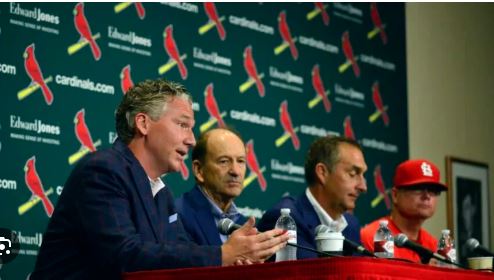
The Cardinals’ drafting savvy is under strain because they are reluctant to spend the money.
Although the St. Louis Cardinals’ motto of selecting and nurturing talented players hasn’t always been successful, their recent hesitancy to make significant moves is placing greater strain on their farm system than it has in the past.
The St. Louis Cardinals have always emphasized that they are a club that develops from within, and in 2025, as they reduce payroll and reaffirm their dedication to selecting players wisely and nurturing them into valuable big league contributors, this attitude will only become more apparent. The Cardinals’ history of selecting lower in the draft has been a sacrifice, according to Cardinals chairman Bill DeWitt Jr., who stated at Winter Warm-Ups that having talented young players coming through the system is the best way to produce a successful club.

However, it isn’t quite accurate to say that the Cardinals have always built their club on homegrown talent. Albert Pujols was the last true superstar to pass through their system. Since then, they have produced strong auxiliary players: Brendan Donovan, Lars Nootbaar, and Alec Burleson may benefit the squad even if they won’t be regarded as stars. But the trade market is what has traditionally helped the Cardinals overcome their slump, and that’s where the current team is falling short.
The Cardinals’ player development is further strained if they are not going to be aggressive in free agency or the trade market.

The Cardinals have made successful trades in the past by exchanging young, highly-regarded players for players who could immediately cover a roster gap. The Cardinals dealt Braden Looper and company to the Florida Marlins in 1998 in exchange for Edgar Renteria, and then transferred Brett Wallace, who Baseball America regarded as their second-ranked prospect at the time, to the Oakland Athletics in 2009 in exchange for Matt Holliday.
The Cardinals have been hesitant to join the deep end of the trade market as contracts for big-name players have become more expensive, and it looks like this reluctance will only increase with the retool. It’s doubtful whether the Cardinals would have made those transactions if Holliday and Renteria had participated in the current game and demanded the kind of compensation that players of their caliber currently fetch.
The Cardinals must hope that their renewed emphasis on the minor levels yields significant outcomes if they are no longer at ease making the trades required to take them from excellent to great. The Cardinals have historically used drafting and development to contend in the postseason, but this year it will be the most important factor in determining how well they can play in the future.
Similar to how batters must always adapt when their deficiencies are identified, the Cardinals must adapt to the new baseball standard as the emergence of analytics and Statcast has pushed them off their high echelon when it comes to appropriate prospect development. The Cardinals have their job cut out for them in terms of improving the lower levels because, as Willson Contreras noted, the team’s minor league system was a shambles.
Leave a Reply